
-
If your ribbon has a File option in the
top left corner, then you're using a desktop version of Outlook and
you're in the right place! See one of the procedures below.
-
If your ribbon doesn't have a File option in the top left corner, see What version of Outlook do I have? to determine your version of Outlook and to get to the right export instructions. Or, see How to get Outlook for your desktop.
Office 365: Export Outlook items to a .pst file
If you have an Office 365 mailbox, you can use Outlook 2007,
2010, 2013, or 2016 to move all of your email, contacts, and calendar
items from one email account into your Office 365 mailbox. How to get Outlook for your desktop
Here's what an Office 365 mailbox looks like in Outlook on the web; Outlook on the web is different from Outlook on your desktop.

After you get Outlook for your desktop, do these steps:
Here's what an Office 365 mailbox looks like in Outlook on the web; Outlook on the web is different from Outlook on your desktop.

After you get Outlook for your desktop, do these steps:
-
Add your "source" email account to Outlook on your desktop. Wait a bit for all of your email and contacts to show up.
-
After you add your Office 365 email account to Outlook on
your desktop, Outlook will automatically sync with your Office 365
account. You'll see the contents of your Office 365 mailbox appear in
Outlook on your desktop.
-
Next, choose from the export instructions in this article (below) to export your email from the source account to a .pst file.For example, if you have Outlook 2010 on your desktop, choose "Outlook 2010: Export Outlook items to a .pst file".
-
Choose from the import instructions to import your email to Office 365.For example, if you have Outlook 2016 on your desktop, choose "Outlook 2013 and Outlook 2016: Import Outlook items from a .pst file".
Because Outlook is syncing with your Office 365 email account, when you import your email using the instructions, the email will go directly into your Office 365 email account.
Outlook 2013 and 2016: Export Outlook items to a .pst file
-
At the top of your Outlook ribbon, choose File.

-
Choose Open & Export > Import/Export.
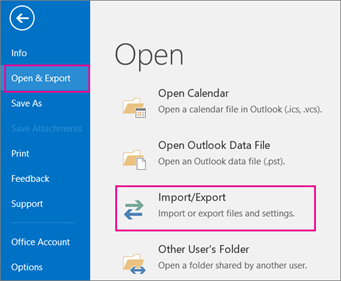
-
Choose Export to a file.
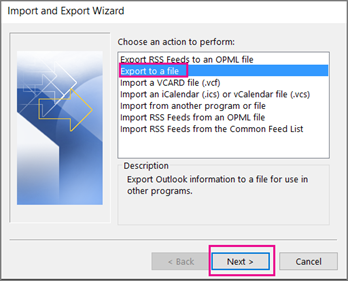
-
Click Outlook Data File (.pst), and then click Next.
-
Select the name of the email account to export, as shown in the picture below. Only information for one account can be exported information at a time.Make sure that the Include subfolders check box is selected. This way everything in the account will be exported: Calendar, Contacts, and Inbox. Choose Next.
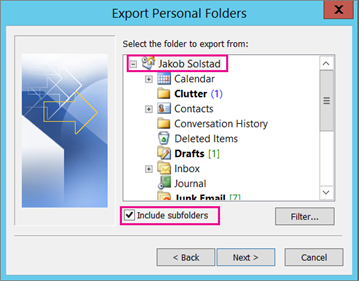
-
Click Browse to select where to save the Outlook Data File (.pst). Type a file name, and then click OK to continue.Note: If you’ve used export before, the previous folder location and file name appear. Type a different file name before clicking OK.
-
If you are exporting to an existing Outlook Data File (.pst), under Options, specify what to do when exporting items that already exist in the file.
-
Click Finish.
-
Outlook begins the export immediately unless a new Outlook Data File (.pst) is created or a password-protected file is used.
-
If you’re creating an Outlook Data File (.pst), an optional password can help protect the file. When the Create Outlook Data File dialog box appears, type the password in the Password and Verify Password boxes, and then click OK. In the Outlook Data File Password dialog box, type the password, and then click OK.
-
If you’re exporting to an existing Outlook Data File (.pst) that is password protected, in the Outlook Data File Password dialog box, type the password, and then click OK.
-
If you’re creating an Outlook Data File (.pst), an optional password can help protect the file. When the Create Outlook Data File dialog box appears, type the password in the Password and Verify Password boxes, and then click OK. In the Outlook Data File Password dialog box, type the password, and then click OK.
Outlook 2010: Export Outlook items to a .pst file
-
At the top of your Outlook ribbon, choose the File tab.

-
Choose Options.
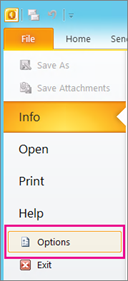
-
In the Outlook Options box, choose Advanced.
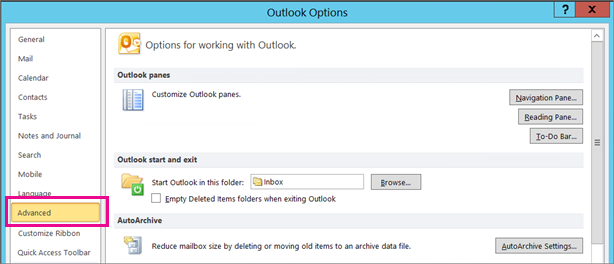
-
Under the Export section, choose Export.

-
Click Export to a file, and then click Next.
-
Click Outlook Data File (.pst), and then click Next.
-
Select the name of the email account to export, as shown in the picture below. Only information for one account can be exported information at a time.Make sure that the Include subfolders check box is selected. This way everything in the account will be exported: Calendar, Contacts, and Inbox. Choose Next.

-
Click Browse to select where you want to save the Outlook Data File (.pst) and to enter a file name. Click OK to continue.Note: If you have previously used the export feature, the previous folder location and file name appear. Make sure that you change the file name if you want to create a new file instead of using the existing file.
-
If you are exporting to an existing Outlook Data File (.pst), under Options, specify what to do when exporting items that already exist in the file.
-
Click Finish.
-
The export begins immediately unless a new Outlook Data File (.pst) is created or the export is to an existing file that is password protected.
-
If you are creating a new Outlook Data File (.pst), an optional password can help protect the file. When the Create Outlook Data File dialog box appears, enter the password in the Password and Verify Password boxes, and then click OK. In the Outlook Data File Password dialog box, enter the password, and then click OK.
-
If you are exporting to an existing Outlook Data File (.pst) that is password protected, in the Outlook Data File Password dialog box, enter the password, and then click OK.
-
If you are creating a new Outlook Data File (.pst), an optional password can help protect the file. When the Create Outlook Data File dialog box appears, enter the password in the Password and Verify Password boxes, and then click OK. In the Outlook Data File Password dialog box, enter the password, and then click OK.
Outlook 2007: Export Outlook items to a .pst file
-
In Outlook 2007, at the top of your ribbon choose File.
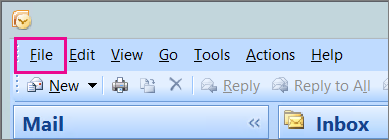
-
Choose Import and Export.
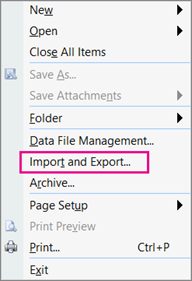
-
Select Export to a file, and then click Next.
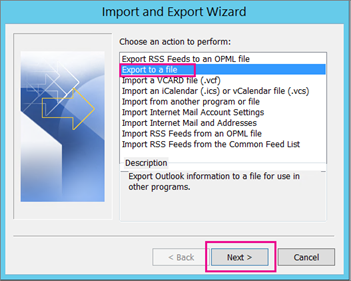
-
Click Personal File Folder (.pst), and then click Next.
-
Select the name of the email account to export, as shown in the picture below. Only information for one account can be exported information at a time.Make sure that the Include subfolders check box is selected. This way everything in the account will be exported: Calendar, Contacts, and Inbox. Choose Next.

-
Click Browse to select where you want to save the Outlook Data File (.pst) and to enter a file name. Click OK to continue.Note: If you have previously used the export feature, the previous folder location and file name appear. Make sure that you change the file name if you want to create a new file instead of using the existing file.
-
If you are exporting to an existing Outlook Data File (.pst), under Options, specify what to do when exporting items that already exist in the file.
-
Click Finish.
-
The export begins immediately ... unless you're creating a new Outlook Data File (.pst) or you're exporting is to an existing .pst file that is password protected. In those cases you'll get this dialog box:
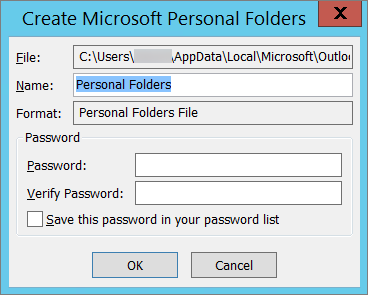
Choose OK if you don't want to password protect your file. Otherwise:
-
If you want to password protect your .pst file: enter the password in the Password and Verify Password boxes, and then click OK. In the Outlook Data File Password dialog box, enter the password, and then click OK.
-
If you are exporting to an existing Personal File Folder (.pst) that is password protected, in the Outlook Data File Password dialog box, enter the password, and then click OK.
-
If you want to password protect your .pst file: enter the password in the Password and Verify Password boxes, and then click OK. In the Outlook Data File Password dialog box, enter the password, and then click OK.
No comments:
Post a Comment